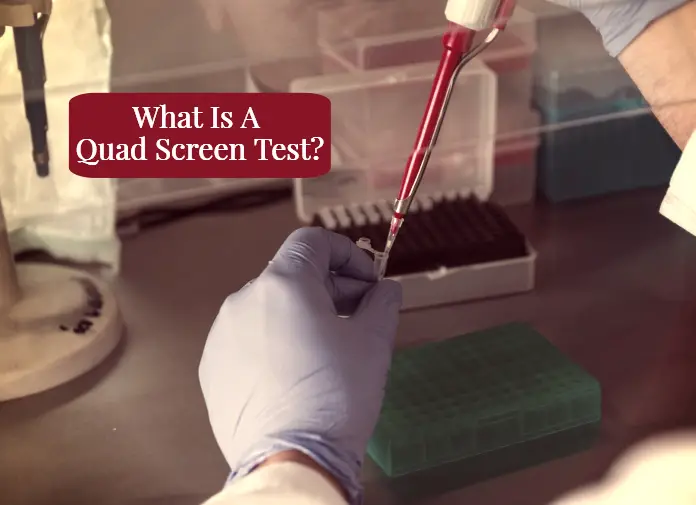A Quadruple screen or Quad screen is a blood screen test during the second-trimester that tests for hCG, estriol, AFP and inhibin A.
All the four chemicals (hCG, estriol, AFP and inhibin A) are present in the bloodstream during 15-22 week of pregnancy. Measuring the levels of these four chemicals, doctors assess the risk of genetic defects.
It’s a screening test and decides the course of tests after that. When the tests are normal, you can skip further genetic tests. Diagnostic genetic tests are more expensive, time-consuming and invasive. Taking a Quad screen test helps you safely check your baby’s health.

What is a Quad Screen Test?
The quad screen is a multiple marker test that assesses the risk of genetic defects in a baby. Women in the second trimester take the AFP4 test. The test looks for chromosomal abnormalities such as trisomy.
Those who are at risk of miscarriage want to avoid getting an amniocentesis. Invasive tests increase the risk of miscarriage in the second trimester. Quad screen test gives a fair hint of the risk without the danger of inducing a miscarriage.
Some women wait for their first prenatal checkup until the time they’re ready for Quad Screen. When both the tests are together, the results are more conclusive. Combined test is integrated or sequential screening.
What does a Quad screen look for?
The Quad Screen looks for:
- AFP: Alpha-Fetoprotein which is a protein that is produced by the baby’s liver and other organs. The higher levels of AFP show a risk of neural tube defect. By the 15th week, AFP starts appearing in the blood of the mother. You can get your Quad Screen until the 20-21 week of the second trimester. With AFP you may come to know if you’re carrying twins. At times the age of baby continues to be miscalculated until the second trimester. For those who get a sequential screening, it’s the first time they know how old is the baby. High AFP values also mean that the baby is older than what you came thinking. Problems in the excretory system such as kidney also lead to elevated AFP values. When a part of the brain or spine doesn’t form, anencephaly, AFP production increases.
- hCG: the placenta produces human Chorionic Gonadotropin after the implantation of the egg. You test it when you use the pregnancy kit. By the second trimester, the hormone reaches its peak with a gradual increase in doubling time. After attaining the peak value, hCG begins to decline. When the levels of hCG continue to be high in the stage, there is a risk of Downs Syndrome. The disorder leads to severe abnormalities and development lapses in the baby. Downs Syndrome occurs because of trisomy of chromosome 21. All genetic material is in the form of pairs of chromosomes. Trisomy means three chromosomes instead of two. Reduced hCG indicates that there is a risk of Edwards Syndrome. There is a wide normal range no pinpoint value, so you don’t have to worry about it.
- Unconjugated Estriol: There are three types of estrogen E1, E2, and E3. Both men and women have estriol. During pregnancy E 3 dominates the other two types. Low levels of E3 in the second trimester indicate the chances of having fetal adrenal defects, neural tube defects, ichthyosis, cholesterol synthesis abnormalities, and miscarriage. High levels of estriol in Quad Screen mean the risk of preterm labor. It also shows the possibility of congenital adrenal hyperplasia. In the condition, additional tissues reduce the number of hormones produced by the adrenal gland.
- Inhibin A: Earlier the Quad Screen was a triple screen. With the addition of inhibin A to the multiple marker screening, it’s now a quad. Inhibin has two types A and B. The levels of Inhibin A along with the other parameters of Quad screen are the marker for Down’s Syndrome in early pregnancy. The New England Journal of Medicine has published Dimeric Inhibin A as a Marker for Down’s Syndrome in Early Pregnancy.1 Other journals also talk of Role of Inhibin in Normal and High-Risk Pregnancy 2. High levels of inhibin A show that there is a high risk of Down’s Syndrome in a developing baby. The abnormal levels also tell about the risk of having preeclampsia.
Why do I need a Quad Screen test?
The quad screen test tells you whether the baby has a risk of Downs Syndrome, neural tube defects or anencephaly. Levels of the four proteins and hormones in the blood have a standard range. When a woman has a higher or lower than normal level of any of the four she is at the risk of having a baby with genetic defects.
Quad screen estimates the risk of
- Downs Syndrome: Trisomy of chromosome 21, causes cognitive disabilities, learning issues, and heart deformity. These children survive until adulthood facing all the difficulties as the disorder isn’t mortal. After Quad screen results a woman with positive results has options such as amniocentesis, chorionic villus sampling, and prenatal cell-free DNA tests.
- Edwards Syndrome: Babies born with Trisomy 18 or Edward Syndrome usually die within the first year or before birth. They have clenched hands and a large head. Hernia, no breathing, and drooping eyelids are some other symptoms of the disorder.
- Anencephaly: A part of the brain or spine doesn’t develop normally. A major neural defect, it’s distinguishable in an ultrasound observing the fluid around the neck.
- Spina Bifida: The spine needs the support of the vertebral column. When the spine doesn’t develop neural networks, don’t function. Spina Bifida risk is also a part of the results of the Quadruple screen second-trimester test.
By the second trimester hCG and other hormones pick up. An increase is enough to be able to support a baby’s development in full swing. A genetic counselor will be able to tell you about the genetic trends in your family. The chances of such development defects can be seen from Pedigree charts.
Generally, a woman must take a precautionary Quadruple screen test. Treating the conditions is way difficult than a simple blood test for quad screen. Once you come to know the results of the quad screen, you will have a clear picture.
Pregnant mums who know their baby’s genetic disposition to a disorder may straightway get a diagnostic test.
When should I take the Quad Screen test?
Screening is done during the 15-21 week. You can take it anytime during the period or whenever your doctor recommends.
Women must take the test as early as possible, who:
- Are older than 35 years
- Have Diabetes type 1
- Were on drugs or exposed to radiation therapy
- Have a history of genetic defects in the family
- Had a miscarriage in a previous pregnancy
How is the Quad Screen done?
For performing the Quad screen, no special procedures are done. A blood test without any specific restrictions on eating or drinking water is all. Results of the test take a week to come for interpretation.
The factors that the test looks for are either made by the baby or placenta. One of these hormones hCG has its peak value in this stage of pregnancy.
Preparing for Quad Screen
You don’t need to do anything for the test. All you have to do is mentally gear up for surviving the period of anxiety if God forbid your results are positive. Out of 50 women positive only 1 or, 2 actually, have babies with genetic defects. False positive results occur for more than one reason. Just a mistake in calculation of your expected delivery date can give an incorrect interpretation.
Quad Screen Results
The normal values of each protein and hCG are multiplied by your age and gestational age. Multiples of the values are considered for the interpretation of results. You don’t see numerical results instead there is a ratio. For, eg. 1:500 chance of having a baby with Downs Syndrome.
Your age comes into play because with increasing age pregnancy-associated risks increase. The test is the primary screening for women who conceive after 35 years of age. Young mothers have a low risk on average than women in their 40s.
Let’s see how you can interpret your quad screen results:
The first thing you understand from the test is whether the risk is positive or you’re not at risk. After that, you can see the individual values of the four markers. Serum levels of estriol <0.3 after multiplying with gestational age in negative test women mean there is a risk of miscarriage and disorders of cholesterol synthesis. So, even after you get a negative test, you still get to know a lot from the values and need an expert to discuss.
A layperson wouldn’t understand the importance of having defects in cholesterol metabolism. Every cell has cholesterol in its membrane.
You also need to understand that neither of the condition positive or negative is the final statement. Out of 1000 women, only 50 have the risk, and 1-2 are affected.
On the other hand, a woman not having a risk might have a baby whose defects aren’t diagnosed yet. Other than a handful of disorders the test tells nothing about the remaining disorders.
There is no need for you to interpret as you will already get a detailed report. Follow up with your doctor, and your counselor will address your doubts, shortly after.
Factors That Affect Quad Screen Results
The accuracy of Quad Screen is 75-81% for Down’s Syndrome, Edward Syndrome and open neural tube defects. About 25% don’t get the actual diagnosis and that can be due to some trivial reasons.
Reasons for false Quad Screen
- Smoking: The nicotine in blood stream affects the markers of Quad Screen and interferes with the test.
- Miscalculation of Baby’s Age: An older baby produces more of the hormones and proteins naturally. Whenever the doctor doesn’t cross check your gestational age, there is a possibility of comparing the wrong set of values.
- Multiples: Quad Screen Twins has slightly different values and you need to tell your doctor before hand if you have multiples.
- Infertility treatment: The fertility drugs for ovulation boosting, alter the hCG levels and obviously affect the results. After IVF treatment such tests are not accurate at early stages. How many times do you get a Quad Screen? During your pregnancy, only a single Multiple Marker Screening is done once.
Maternal race and weight also affect the accuracy of the Quad Screen test.
Risks of Quad Screen
The test poses no risk to the baby or mother. Like a regular blood test the quad screen only involves a light sting. You can eat and drink anything and get to activities immediately.
Anxiety is deafening and that’s what some pregnant women would never want to face. After a Quad Screen not all women agree for taking invasive tests. When the screening results are positive they mean an increased risk. After coming to know about the risk of having a baby with genetic defects, one has to continue for days in the anxiety.
Results of amniocentesis showing a fetus with a disorder, call for terminating the pregnancy. Some couples for religious, ethical and emotional reasons would never think of abortion. That’s why they chose to skip such tests and continue with the pregnancy whatsoever.
Alternative Tests to Quad Screen
Follow up for Quad Screen or as alternatives you have a wide variety of genetic tests available.
- Prenatal Cell Free DNA test: The maternal blood starts showing cell free DNA from fetus within the early weeks of pregnancy. All the prenatal tests that are confirmatory are generally invasive. However, prenatal cell free DNA test evaluates the same without anything but a blood test. The genetic material is the blueprint of the entire body and course of life. You can get all the information regarding your baby’s genetic makeup from the DNA.
- Amniocentesis: The amniotic fluid has a lot of free floating cells from the fetus. A thin needle is inserted through the vagina or the bump to draw some amount of amniotic fluid. There is a high risk of poking the baby and puncturing which scares mothers. Sample sent to the laboratory is tested and then reports come after a week.
- Chorionic Villus Sampling: Unlike the fluid used for amniocentesis in CVS a small tissue is removed from the chorionic villi. Just like the previous test CVS can also diagnoses a number of genetic diseases in the baby.
- Ultrasound: After discovering the risk of neural tube defects your doctor can do the nuchal translucency scan to see fluid around the head. Excess fluid near the head region indicates the occurrence of an open tube.
Final Words
Whether you can handle anxiety or mental flux during such tests is only your judgment. These tests are good for those who are strong willed and can take steps like terminating the pregnancy. Ones who are fixed on having the baby don’t seem to have a point taking this test. You have to do what is best for your baby and you.









